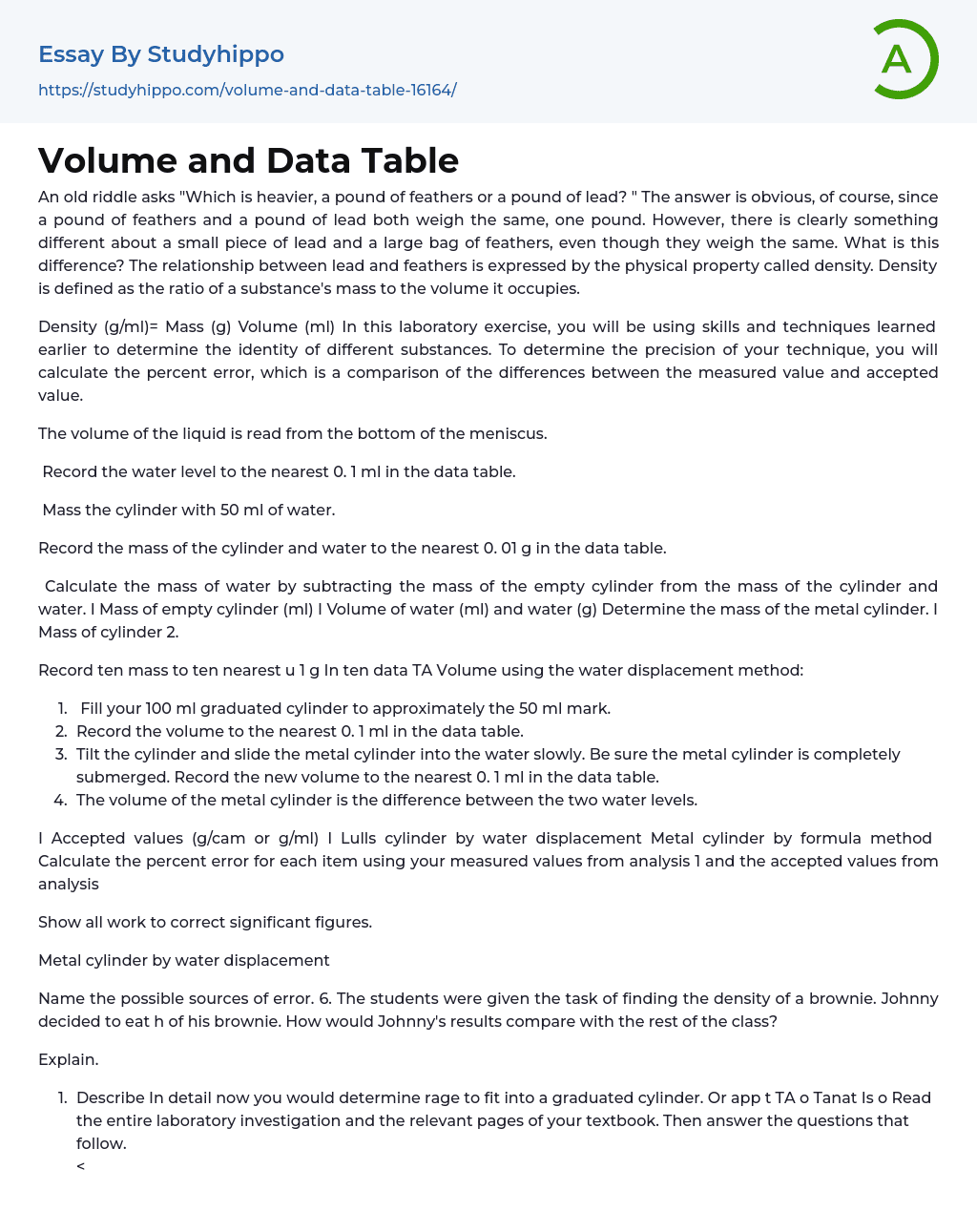The question "Which is heavier, a pound of feathers or a pound of lead?" emphasizes that both feathers and lead have the same weight of one pound. Nevertheless, there is a distinct contrast between a small piece of lead and a large bag of feathers despite their equal weight. This dissimilarity can be clarified by the concept of density, which denotes the ratio of mass to volume for any substance.
During this lab activity, you will apply your previously acquired skills and techniques to identify various substances. To assess the accuracy of your technique, calculate the percent error by comparing the measured value with the accepted value. The formula for density (g/ml) is Mass (g) divided by Volume (ml).
The level of the liquid is determined by reading the measurement at the bottom of
...the meniscus.
In the data table, record the water level to the nearest 0.1 ml.
Fill the cylinder with 50 ml of water.
In the data table, document the mass of both the cylinder and water with a precision of 0.01 g.
To find the mass of water, subtract the mass of the empty cylinder from the total mass of both the cylinder and water. Also, calculate the mass of the metal cylinder.
Record the mass of ten objects to the nearest 0.1 gram in the data table labeled TA Volume using the water displacement method:
- Fill your 100 ml graduated cylinder to approximately the 50 ml mark.
- Record the volume to the nearest 0. 1 ml in the data table.
- Tilt the cylinder and slide the metal cylinder into th
water slowly. Be sure the metal cylinder is completely submerged. Record the new volume to the nearest 0. 1 ml in the data table.
The values are measured in grams per cubic centimeter (g/cm) or grams per milliliter (g/mL). The volume of the cylinder is determined through water displacement, while the volume of the metal cylinder is calculated using a formula. To find the percent error for each item, compare your measured values from analysis 1 with the accepted values from analysis.
Please demonstrate all calculations to ensure correct significant figures are used.
A metal cylinder is measured using water displacement.
Identify the potential error sources. 6. The students were asked to determine the density of a brownie. Johnny opted to consume h of his brownie. How would Johnny's findings compare to those of the rest of the class?
Provide an explanation.
- Describe In detail now you would determine rage to fit into a graduated cylinder. Or app t TA o Tanat Is o Read the entire laboratory investigation and the relevant pages of your textbook. Then answer the questions that follow.
- What two properties of matter are used to determine its density?
- What pieces of laboratory equipment would you use to measure the properties needed to determine the density of a substance?
- Using the properties stated in question 1, write the formula for density.
- What two sets of units can be used to describe density?
- Why are they interchangeable?
The volume of a cylinder can be calculated using the formula:
The volume (V) of a cylinder can be determined by using the given height (h) of 3.52 cm and radius (r) of 0.89 cm. Both a pound of feathers and a pound of lead weigh the same, one pound. However, there is a clear distinction between a small piece of lead and a large bag of feathers, despite having the same weight. This distinction is expressed through density, which is defined as the ratio of an object's mass to its volume.
In this laboratory exercise, you will use your previous skills and techniques to identify different substances. The formula for density (g/ml) is Mass (g) divided by Volume (ml). To determine the accuracy of your technique, you will calculate the percent error by comparing the measured value with the accepted value.
The liquid volume is measured from the lower part of the meniscus.
- Record the water level to the nearest 0. 1 ml in the data table.
Mass the cylinder with 50 ml of water.
Using the water displacement method, record ten measurements of mass to the nearest 1 gram in the data TA Volume.
- Fill your 100 ml graduated cylinder to approximately the 50 ml mark.
- Record the volume to the nearest 0. 1 ml in the data table.
- Tilt the cylinder and slide the metal cylinder into the water slowly. Be sure the metal cylinder is completely submersed.
- Record the new volume to the nearest 0. 1 ml in the data table.
- The volume of the metal cylinder is the difference between the two water levels.
The following text has beenwhile preserving the and their contents:
- Atom essays
- Big Bang Theory essays
- Density essays
- Electricity essays
- Energy essays
- Force essays
- Heat essays
- Light essays
- Motion essays
- Nuclear Power essays
- Physiology essays
- Sound essays
- Speed essays
- Temperature essays
- Thermodynamics essays
- Mass essays
- John Locke essays
- 9/11 essays
- A Good Teacher essays
- A Healthy Diet essays
- A Modest Proposal essays
- A&P essays
- Academic Achievement essays
- Achievement essays
- Achieving goals essays
- Admission essays
- Advantages And Disadvantages Of Internet essays
- Alcoholic drinks essays
- Ammonia essays
- Analytical essays
- Ancient Olympic Games essays
- APA essays
- Arabian Peninsula essays
- Argument essays
- Argumentative essays
- Art essays
- Atlantic Ocean essays
- Auto-ethnography essays
- Autobiography essays
- Ballad essays
- Batman essays
- Binge Eating essays
- Black Power Movement essays
- Blogger essays
- Body Mass Index essays
- Book I Want a Wife essays
- Boycott essays
- Breastfeeding essays
- Bulimia Nervosa essays
- Business essays




